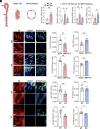METTL3 mediates atheroprone flow-induced glycolysis in endothelial cells
- PMID: 40327688
- PMCID: PMC12088407
- DOI: 10.1073/pnas.2424796122
METTL3 mediates atheroprone flow-induced glycolysis in endothelial cells
Abstract
Atheroprone flow-increased glycolysis in vascular endothelial cells (ECs) is pivotal in EC dysfunction and the initiation of atherosclerosis. Methyltransferase 3 (METTL3) is a major m6A methyltransferase for RNA N6-mehtyladenosine (m6A) modifications to regulate epitranscriptome and cellular functions. With the atheroprone flow upregulating METTL3 and m6A RNA hypermethylation, we investigate the role of METTL3 in atheroprone flow-induced glycolysis in ECs in vitro and in vivo. Compared to pulsatile shear stress (PS, atheroprotective flow), oscillatory shear stress (OS, atheroprone flow) increases METTL3 expression to enhance the m6A modifications of mRNAs encoding HK1, PFKFB3, and GCKR, which are rate-limiting enzymes of glycolysis. These augmented m6A modifications increase the expressions of HK1 and PFKFB3 while decreasing GCKR, resulting in elevated EC glycolysis, as revealed by seahorse analysis. Moreover, a stimulated Raman scattering (SRS) imaging study demonstrates the elevation of glucose incorporation into de novo synthesized lipids in ECs under atheroprone flow in vitro and in vivo. Empagliflozin, a sodium-glucose cotransporter-2 inhibitor (SGLT2i) drug, represses METTL3 expression, thereby mitigating OS-induced glycolysis in ECs. These data suggest mechanisms by which METTL3 links EC mechanotransduction with metabolic reprogramming under atherogenic conditions.
Keywords: atherosclerosis; endothelial cell; glycolysis; shear stress.
Conflict of interest statement
Competing interests statement:The authors declare no competing interest.
Figures





References
-
- Doddaballapur A., et al. , Laminar shear stress inhibits endothelial cell metabolism via KLF2-mediated repression of PFKFB3. Arterioscler Thromb. Vasc. Biol. 35, 137–145 (2015). - PubMed
MeSH terms
Substances
Grants and funding
LinkOut - more resources
Full Text Sources
Medical
Miscellaneous

